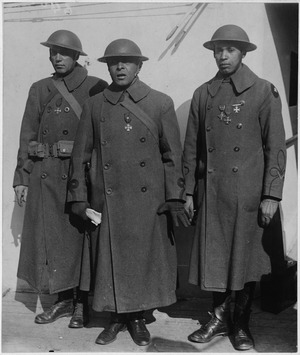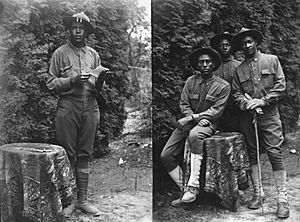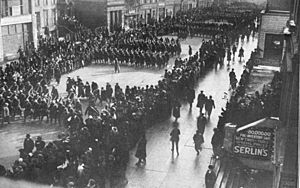370th Infantry Regiment (United States) facts for kids
Quick facts for kids 370th Infantry Regiment |
|
|---|---|
| Active | 1917–1918 1942–1946 |
| Country | USA |
| Branch | United States Army National Guard |
The 370th Infantry Regiment was a special unit in the United States Army National Guard. It was part of the 93rd (Provisional) Infantry Division during World War I. This regiment was unique because it was the only U.S. Army combat unit with all African-American officers.
Soldiers of the 370th were known as the "Black Devils." They earned this nickname for their brave and fierce fighting during World War I. Later, in World War II, the regiment became part of the 92nd Infantry Division.
This regiment started as the Illinois 8th National Guard. It was also called the "Fighting 8th." This unit made history during the Spanish-American War because all its officers were African-American. Today, the Victory Monument in Chicago honors the World War I unit.
Contents
The Illinois 8th National Guard

The Illinois 8th National Guard was an all-black military group. It was first formed in the 1870s. In 1898, the Governor of Illinois brought the unit back for the Spanish-American War. This was when it first made history. It was the only regiment in the entire country led by African-American officers.
The Eighth Regiment Armory is in Chicago, Illinois. It was built in 1914. This was the first armory in the United States built for an African-American military regiment. When the unit joined the national army for World War I, it was renamed the 370th.
The 370th in World War I
In World War I, the African-American 8th Infantry became the 370th Infantry. They fought alongside French forces. This unit was special because it was the only one fully commanded by black officers.
The 370th Infantry served with great honor. They fought in important battles like Lorraine and Oise-Aisne. They were involved in areas such as Saint Mihiel and the Argonne Forest. One part of the regiment, led by Lieutenant Colonel Otis B. Duncan, was far ahead of other troops. They were chasing the enemy when the war ended.
The German soldiers gave the regiment the name "Black Devils" (German: Schwarze Teufel). This was because of their brave fighting in the Argonne. The Victory Monument in Chicago honors these soldiers. It was built to remember the service of the Eighth Regiment of the Illinois National Guard in World War I.
The 370th in World War II
The 370th Regiment was brought back into service in October 1942. This was ten months after the United States joined World War II. After almost two years of training, they left the U.S. in July 1944. They arrived in Italy on August 1st.
The 370th began fighting on August 24, 1944. They were part of the U.S. Fifth Army. They helped cross the Arno River and took over the city of Lucca. They also pushed through the Gothic Line as the enemy retreated.
Later, the 370th was part of Task Force 45. This group was in charge of the Italian coast. They continued to patrol and fight. In December, enemy forces attacked, making the 92nd Division units pull back. The attack ended a few days later.
In February 1945, the 92nd Division attacked again. They fought against Italian forces. On April 1st, the 370th and the 442nd Infantry (Nisei) attacked the Ligurian coast. They quickly moved north against German and Italian units.
The 370th chased the retreating enemy from April 18th until the enemy collapsed on April 29, 1945. Parts of the 92nd Division entered La Spezia and Genoa on April 27th. They took control of towns along the coast until the enemy surrendered on May 2, 1945.
In Italy, the "Buffalo Soldiers" met many different people. They fought alongside other American groups, like Japanese descendants. They also met soldiers from British and French colonies. These included Black Africans, Moroccans, and Gurkhas. They also met Polish, Greek, and Czech soldiers. Anti-fascist Italians and soldiers from the Brazilian Expeditionary Force were also there.
Today, this regiment is known as the 178th Infantry Regiment.
Notable Members
- Charlie Alexander: A band sergeant for the 370th in 1917. He later became a famous jazz musician.
- Lieutenant Colonel Otis B. Duncan: He led the 3rd Battalion of the 370th in battle.
- Sergeant Matthew Jenkins: He received two important awards for his bravery. He led his platoon in combat and held a German position for 36 hours.
- William J. Powell: An engineer and aviation pioneer. He was wounded during a gas attack as an officer.
- Vernon Baker: A U.S. Army Medal of Honor recipient.
- Marshall Allen: A jazz musician and leader of The Sun Ra Arkestra.



